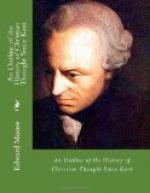In the year 1848 Bushnell was invited to give addresses at the Commencements of three divinity schools: that at Harvard, then unqualifiedly Unitarian; that at Andover, where the battle with Unitarianism had been fought; and that at Yale, where Bushnell had been trained. The address at Cambridge was on the subject of the Atonement; the one at New Haven on the Divinity of Christ, including Bushnell’s doctrine of the trinity; the one at Andover on Dogma and Spirit, a plea for the cessation of strife. He says squarely of the old school theories of the atonement, which represent Christ as suffering the penalty of the law in our stead: ’They are capable, one and all of them, of no light in which they do not offend some right sentiment of our moral being. If the great Redeemer, in the excess of his goodness, consents to receive the penal woes of the world in his person, and if that offer is accepted, what does it signify, save that God will have his modicum of suffering somehow; and if he lets the guilty go he will yet satisfy himself out of the innocent?’ The vicariousness of love, the identification of the sufferer with the sinner, in the sense that the Saviour is involved by his desire to help us in the woes which naturally follow sin, this Bushnell mightily affirmed. Yet there is no pretence that he used vicariousness or satisfaction in the same sense in which his adversaries did. He is magnificently free from all such indirection. In the New Haven address there is this same combination of fire and light. The chief theological value of the doctrine of the trinity, as maintained by the New England Calvinistic teachers, had been to furnish the dramatis personae for the doctrine of the atonement. In the speculation as to the negotiation of this substitutionary transaction, the language of the theologians had degenerated into stark tritheism. Edwards, describing the councils of the trinity, spoke of the three persons as ‘they.’ Bushnell saw that any proper view of the unity of God made the forensic idea of the atonement incredible. He sought to replace the ontological notion of the trinity by that of a trinity of revelation, which held for him the practical truths by which his faith was nourished, and yet avoided the contradictions which the other doctrine presented both to reason and faith. Bushnell would have been far from claiming that he was the first to make this fight. The American Unitarians had been making it for more than a generation. The Unitarian protest was wholesome. It was magnificent. It was providential, but it paused in negation. It never advanced to construction. Bushnell’s significance is not that he fought this battle, but that he fought it from the ranks of the orthodox Church. He fought it with a personal equipment which Channing had not had. He was decades later in his work. He took up the central religious problem when Channing’s successors were following either Emerson or Parker.




